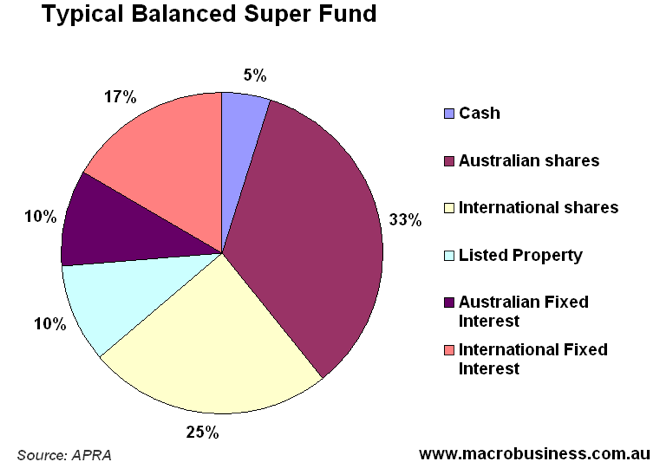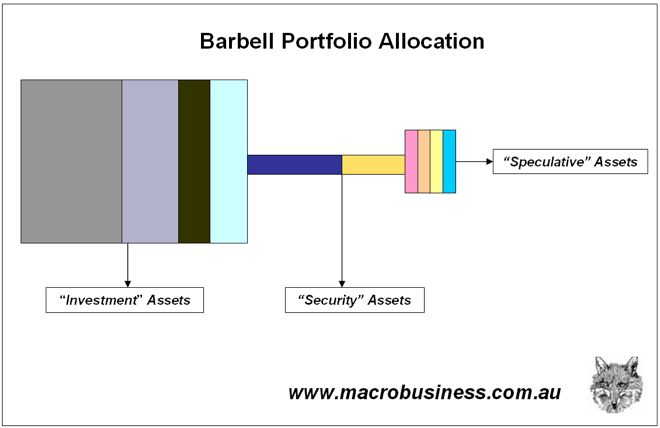Yesterday SuperRatings issued its September results for Australian superannuation funds. September continued the poor performance of this year, with year to date returns for a balanced fund of minus 4.88%. Eighty percent of investors have their super in a balanced fund so the pain is widespread. It doesn’t get much better when we look at the longer term. Balanced fund returns are up 0.92% per annum over five years and 5.16% per annum over ten years, barely above inflation or, for that matter, cash returns.
This is not an anomaly due to the GFC – super fund performance has simply been woeful:

With returns like this, investors have every right to ask why are they paying to have their super managed by someone else and, for those in a retail fund, why are they are paying 1-2% a year in fees to get the same return as cash?
So, why have balanced funds so underperformed? The principle reason is they are heavily weighted towards high risk growth assets, which can capture upside but expose you to downside.
Imagine your super placed in a circular pie tin. Your adviser or fund – based on your “risk profile” – cooks the pie and more than just a few crumbs are lost in the cooking by way of brokerage, management fees and adviser commission and for the majority, you end up with what is called a “balanced” asset allocation with approximately 70% allocated to growth style assets.

This is what we have all been lead to believe is the correct and prudent method for allocating assets.
The reality is it a disastrous way to allocate your retirement funds. The focus is always on the potential reward – not on the risk, and particularly not the “unexpected” risk that continually shakes up equity markets around the world.
Do some heavy lifting
Imagine you’re at the gym – you need to get rid of that pie you’ve just eaten – and have decided to get into some weightlifting.
You reach for a barbell – but this one is very strange. There are sets of weights on each end, but they are not the same size, nor are they the same metal, but strangest of all, one end is much, much larger than the other – or asymmetric. On further examination, the bar that connects the weight together is not made of stainless steel, but gold and timber.
Almost all of the large weights on the left are conventional iron discs, with a little surface rust on them. The remaining weights are the same shape and size, but appear to be made of titanium or tungsten. Each weight is firmly locked on the bar by a small but sturdy clip.
The weights on the right are of various shapes and sizes – including some that barely fit into your hand and some that look similar to the tungsten weights on the left. You start to recollect your high school chemistry lessons and recognise a few – sodium, iridium and maybe silver? You quickly notice that the weights are not secured and precariously hang freely.
This strategy is called a “barbell asset allocation“, championed by Black Swan author Nassim Taleb who brought the idea into the amateur investment world with his concepts of risk and non-linearity.

Combine this method with the the notion that there are only two classes of investors, the “professional” who effectively runs their portfolio as a part time job, has higher levels of experience and can tolerate larger levels of speculation, or the “amateur” who is both time constrained and less tolerant of speculative activities, and you have a powerful and superior model on which to grow and protect your super.
Assets aren’t Assets
Before assembling your barbell portfolio, you need to toss away the traditional way of treating assets. Instead of being focused on the potential returns by dividing your portfolio into the traditional “growth” (shares, property) and “defensive” (cash,fixed interest) areas, assets need to based on the concepts of risk, uncertainty and security of your capital.
Let’s call these three categories “security“, “investment” and “speculative” assets, with clearly divided attributes, so you can tell one from the other and “weight” your portfolio correctly.
The first are “security assets” – this is the gold and timber bar that binds your portfolio together – and examples include insurance, physical precious metals, liquid cash, with a weighting of 5-20% of your total portfolio.
They have some or all of the following attributes:
- Non-yielding (or non-reliance on any yield)
- Non-speculative
- Un-leveraged
- Non-invested or managed
- Secure property right (physical or legal)
- Intangible insurance (e.g health or life)
Security assets are usually ignored, defined incorrectly or completely misallocated by traditional techniques. They are not the same as conventional wealth creating or income assets because they are the security – the bar – that connects and forms the base of your super. If you lose everything else, you can use this base to begin building again.
“Investment” assets must have all of the following attributes, or they will fall into the “speculative” asset category:
- High or complete certainty of original capital return
- Known and calculated payoff in yield/earnings
- Zero or very low leverage preferably
- Provide at minimum same yield as government bond
- Zero risk, or known risk that can be adequately insured
This should comprise the majority of your capital, approx 80-90% for an “amateur” and no less than 50% for a “professional” and provide the balance of your super fund’s income and capital gains.
The critical point about “investment assets” – is that they have known payoffs and a known certainty about the return of your original capital – that is, they have competely insurable risks. They are definable risk assets that provide you with psychological security, knowing they will get two types of returns: a continuing annual yield and a return of the original capital.
The main “iron” investments here would be annuities, followed by government and corporate bonds, term deposits, certain property investments (whilst avoiding concentration and high leverage) and a very small population of listed stocks (and not necessarily “blue chips”). Passive index following strategies in lieu of outright stock picking is acceptable and the usual route of the “amateur” investor, but must also be completely hedged, usually through portfolio insurance.
Assets that do not have all of these factors are “speculative assets” and must not comprise more than 10% of your total portfolio. The main attributes are:
- Uncertainty of return of capital
- Unknown but possibly very high payoff
- Unmeasurable risk (low or high)
- A known/estimated but uninsurable risk
- Any leverage exceeding 50% LVR (i.e more than half is borrowed)
- Depends upon underlying price volatility for positive returns (i.e is negatively geared or has negligible yield)
- Uninsurable/cannot be completely hedged
These assets can be broad or focused on a single strategy but usually involve speculating in secondary asset markets, although a great majority are deluded that this is “investing”. Typical examples include securities trading, real estate speculation (especially if negatively geared) and any type of non-insurable share investment. Leverage is usually an integral or critical part of these strategies, they should be at limited recourse to your investment and security assets, and you should expect them to suffer heavy losses as a normal course of events.
However, done correctly, a small allocation can produce very high payoffs that provide a “kicker” to your staid and steady returns from your boring investment assets. For the “professional” investor, the majority of your time and focus will be on researching and implementing these strategies to try to capture additional returns.
It’s time to change the way you think about investing, particularly in super. The industry has long forgotten that risk – the actual loss of capital – should be the focus, and gaining modest, absolute returns over the long run is the only way to both build and protect your portfolio from highly volatile markets. A barbell portfolio enhances the absolute returns of cash by offering controlled exposure to potential upside whilst protecting against the downside.
It’s time to put that pie away and do some heavy lifting.
This is Part One of a two-part series on the Barbell Portfolio. Part Two will include worked examples and strategies for the Amateur and Professional investors and how to use this method outside superannuation.
Previous articles in the series include my contentions that traditional asset allocation doesn’t work and the managed funds industry prefer “relative” returns to absolute returns: Problem with Asset Allocation and Troubles with Fund Management. From this comes the realisation that you need two financial plans and, as well as choosing what type of investor you will be: Master yourself, then markets. Further, I have cautioned against the reliance upon share market “averages”, and counseled caution in sideways markets: Relying on Stock Market averages. Finally, the Great Moderation is over and not to be repeated so prepare for: The Great Volatility.